Project Risk Management and Analysis: CA Energy Project Midterm
VerifiedAdded on 2022/12/15
|11
|2782
|486
Homework Assignment
AI Summary
This assignment addresses project risk management, focusing on the CA Energy Project. It begins by defining high-risk scenarios, such as schedule delays and intellectual property risks, and introduces the Risk Breakdown Structure (RBS) for categorizing risks. The assignment then explores scope creep, its causes, and mitigation strategies. It delves into quantitative risk analysis methods, including probability distributions, decision tree analysis, and sensitivity analysis. The assignment provides a risk register with identified risks and their descriptions, probabilities, and impact ratings. Finally, it identifies the top seven risks, detailing each risk's description, probability, and impact, providing a comprehensive overview of project risk management and analysis within the context of the CA Energy Project.

MANAGING RISK IN PROJECTS
Managing Risk in Projects
Managing Risk in Projects
Paraphrase This Document
Need a fresh take? Get an instant paraphrase of this document with our AI Paraphraser
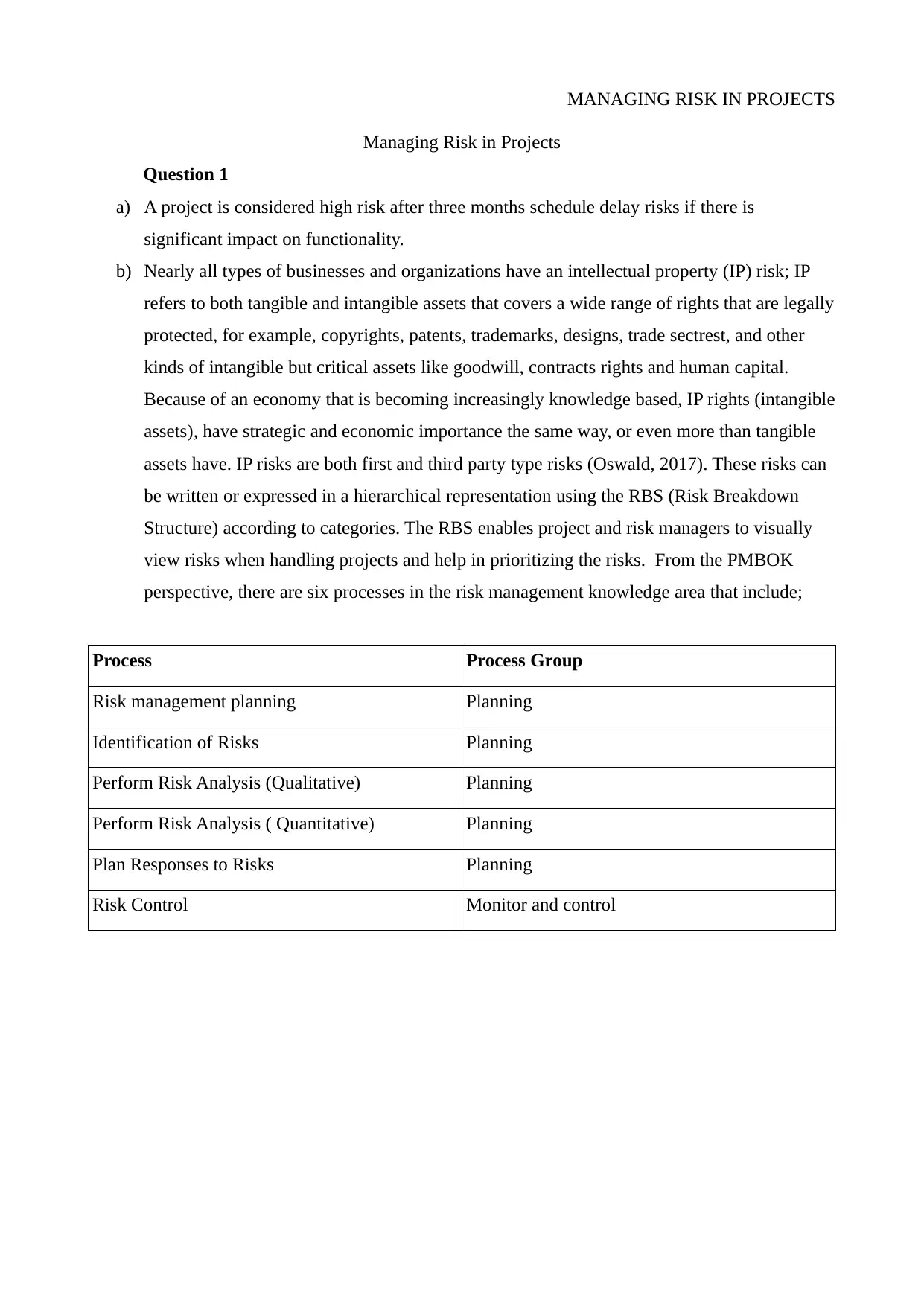
MANAGING RISK IN PROJECTS
Managing Risk in Projects
Question 1
a) A project is considered high risk after three months schedule delay risks if there is
significant impact on functionality.
b) Nearly all types of businesses and organizations have an intellectual property (IP) risk; IP
refers to both tangible and intangible assets that covers a wide range of rights that are legally
protected, for example, copyrights, patents, trademarks, designs, trade sectrest, and other
kinds of intangible but critical assets like goodwill, contracts rights and human capital.
Because of an economy that is becoming increasingly knowledge based, IP rights (intangible
assets), have strategic and economic importance the same way, or even more than tangible
assets have. IP risks are both first and third party type risks (Oswald, 2017). These risks can
be written or expressed in a hierarchical representation using the RBS (Risk Breakdown
Structure) according to categories. The RBS enables project and risk managers to visually
view risks when handling projects and help in prioritizing the risks. From the PMBOK
perspective, there are six processes in the risk management knowledge area that include;
Process Process Group
Risk management planning Planning
Identification of Risks Planning
Perform Risk Analysis (Qualitative) Planning
Perform Risk Analysis ( Quantitative) Planning
Plan Responses to Risks Planning
Risk Control Monitor and control
Managing Risk in Projects
Question 1
a) A project is considered high risk after three months schedule delay risks if there is
significant impact on functionality.
b) Nearly all types of businesses and organizations have an intellectual property (IP) risk; IP
refers to both tangible and intangible assets that covers a wide range of rights that are legally
protected, for example, copyrights, patents, trademarks, designs, trade sectrest, and other
kinds of intangible but critical assets like goodwill, contracts rights and human capital.
Because of an economy that is becoming increasingly knowledge based, IP rights (intangible
assets), have strategic and economic importance the same way, or even more than tangible
assets have. IP risks are both first and third party type risks (Oswald, 2017). These risks can
be written or expressed in a hierarchical representation using the RBS (Risk Breakdown
Structure) according to categories. The RBS enables project and risk managers to visually
view risks when handling projects and help in prioritizing the risks. From the PMBOK
perspective, there are six processes in the risk management knowledge area that include;
Process Process Group
Risk management planning Planning
Identification of Risks Planning
Perform Risk Analysis (Qualitative) Planning
Perform Risk Analysis ( Quantitative) Planning
Plan Responses to Risks Planning
Risk Control Monitor and control
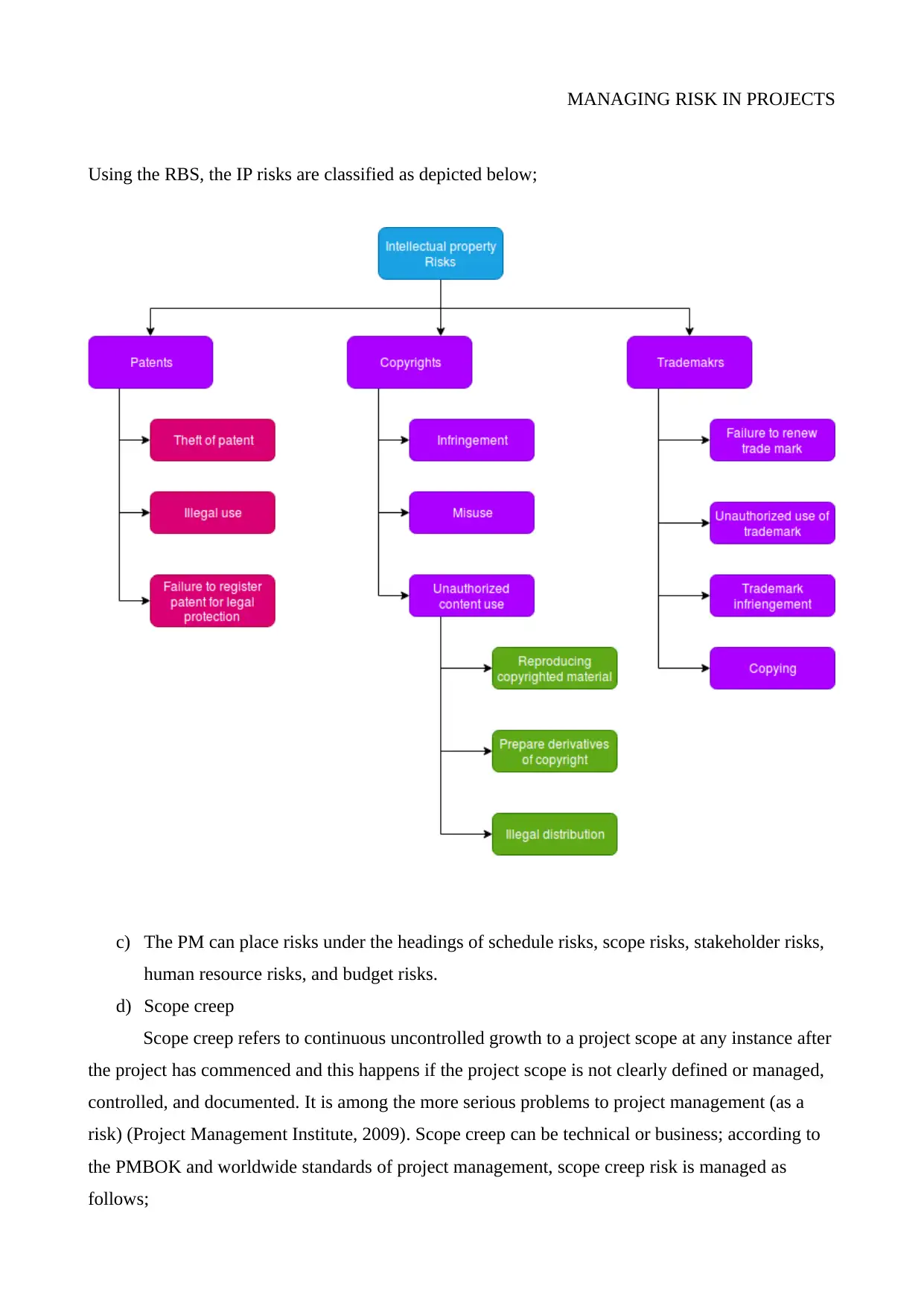
MANAGING RISK IN PROJECTS
Using the RBS, the IP risks are classified as depicted below;
c) The PM can place risks under the headings of schedule risks, scope risks, stakeholder risks,
human resource risks, and budget risks.
d) Scope creep
Scope creep refers to continuous uncontrolled growth to a project scope at any instance after
the project has commenced and this happens if the project scope is not clearly defined or managed,
controlled, and documented. It is among the more serious problems to project management (as a
risk) (Project Management Institute, 2009). Scope creep can be technical or business; according to
the PMBOK and worldwide standards of project management, scope creep risk is managed as
follows;
Using the RBS, the IP risks are classified as depicted below;
c) The PM can place risks under the headings of schedule risks, scope risks, stakeholder risks,
human resource risks, and budget risks.
d) Scope creep
Scope creep refers to continuous uncontrolled growth to a project scope at any instance after
the project has commenced and this happens if the project scope is not clearly defined or managed,
controlled, and documented. It is among the more serious problems to project management (as a
risk) (Project Management Institute, 2009). Scope creep can be technical or business; according to
the PMBOK and worldwide standards of project management, scope creep risk is managed as
follows;
⊘ This is a preview!⊘
Do you want full access?
Subscribe today to unlock all pages.

Trusted by 1+ million students worldwide
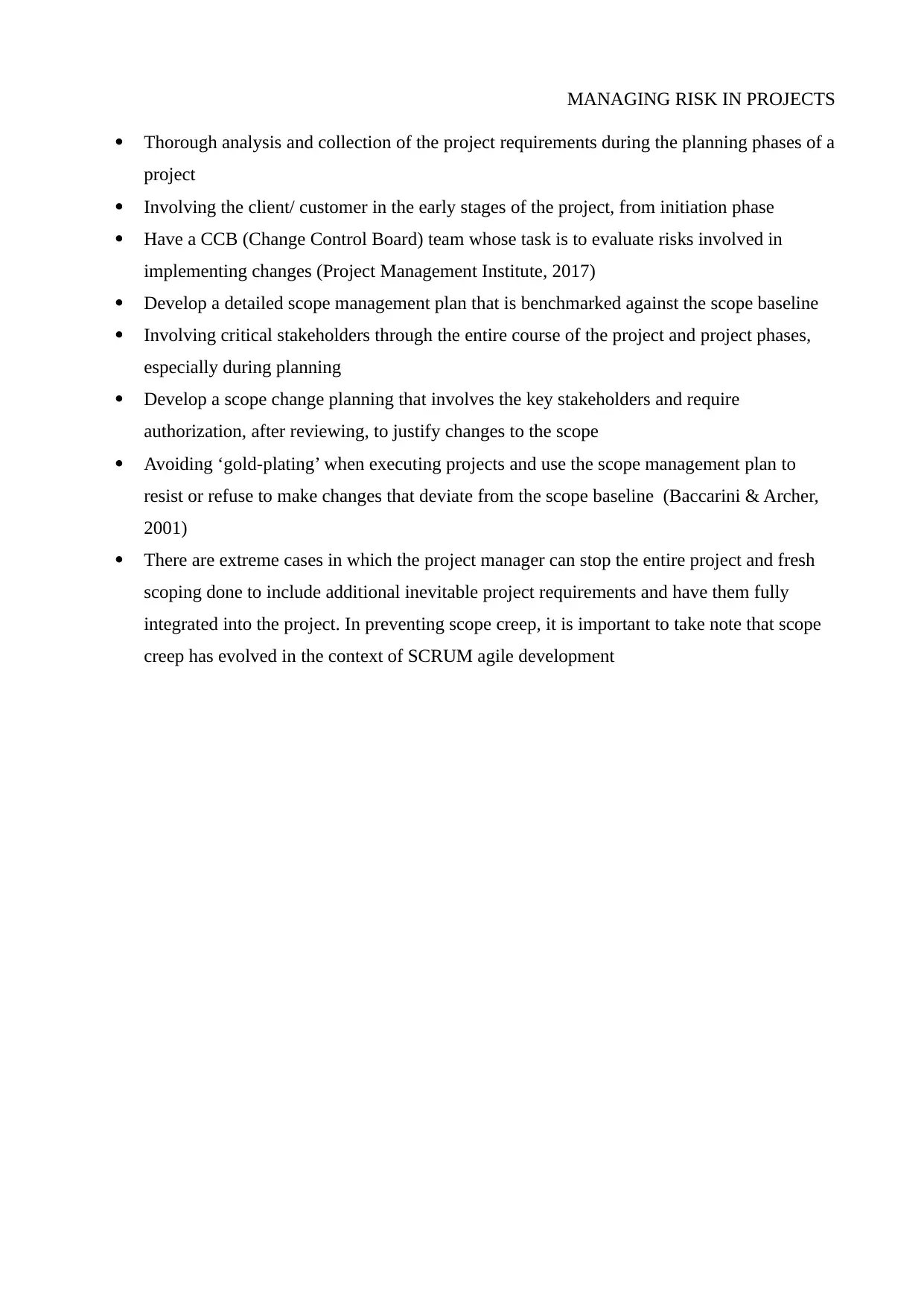
MANAGING RISK IN PROJECTS
Thorough analysis and collection of the project requirements during the planning phases of a
project
Involving the client/ customer in the early stages of the project, from initiation phase
Have a CCB (Change Control Board) team whose task is to evaluate risks involved in
implementing changes (Project Management Institute, 2017)
Develop a detailed scope management plan that is benchmarked against the scope baseline
Involving critical stakeholders through the entire course of the project and project phases,
especially during planning
Develop a scope change planning that involves the key stakeholders and require
authorization, after reviewing, to justify changes to the scope
Avoiding ‘gold-plating’ when executing projects and use the scope management plan to
resist or refuse to make changes that deviate from the scope baseline (Baccarini & Archer,
2001)
There are extreme cases in which the project manager can stop the entire project and fresh
scoping done to include additional inevitable project requirements and have them fully
integrated into the project. In preventing scope creep, it is important to take note that scope
creep has evolved in the context of SCRUM agile development
Thorough analysis and collection of the project requirements during the planning phases of a
project
Involving the client/ customer in the early stages of the project, from initiation phase
Have a CCB (Change Control Board) team whose task is to evaluate risks involved in
implementing changes (Project Management Institute, 2017)
Develop a detailed scope management plan that is benchmarked against the scope baseline
Involving critical stakeholders through the entire course of the project and project phases,
especially during planning
Develop a scope change planning that involves the key stakeholders and require
authorization, after reviewing, to justify changes to the scope
Avoiding ‘gold-plating’ when executing projects and use the scope management plan to
resist or refuse to make changes that deviate from the scope baseline (Baccarini & Archer,
2001)
There are extreme cases in which the project manager can stop the entire project and fresh
scoping done to include additional inevitable project requirements and have them fully
integrated into the project. In preventing scope creep, it is important to take note that scope
creep has evolved in the context of SCRUM agile development
Paraphrase This Document
Need a fresh take? Get an instant paraphrase of this document with our AI Paraphraser
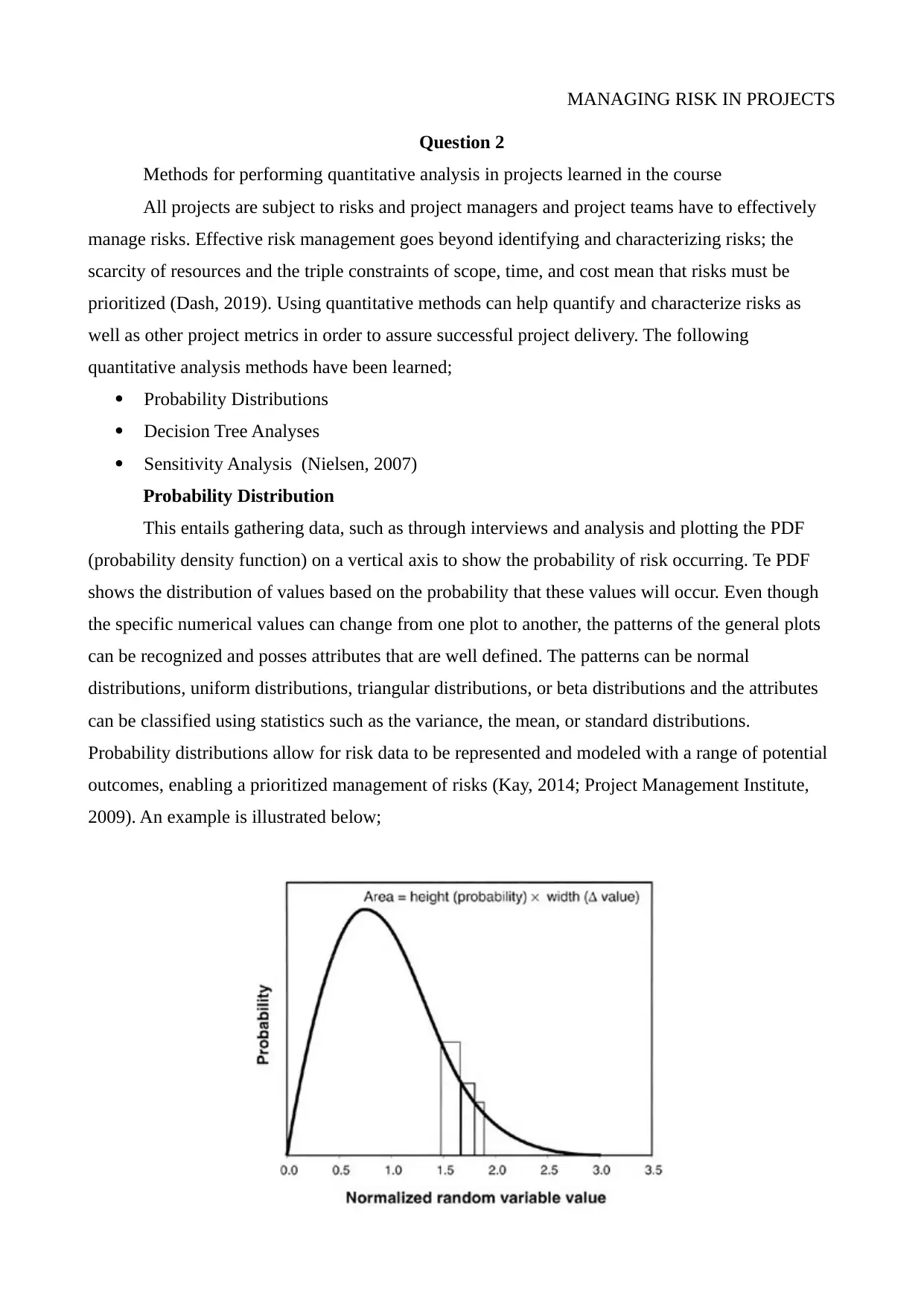
MANAGING RISK IN PROJECTS
Question 2
Methods for performing quantitative analysis in projects learned in the course
All projects are subject to risks and project managers and project teams have to effectively
manage risks. Effective risk management goes beyond identifying and characterizing risks; the
scarcity of resources and the triple constraints of scope, time, and cost mean that risks must be
prioritized (Dash, 2019). Using quantitative methods can help quantify and characterize risks as
well as other project metrics in order to assure successful project delivery. The following
quantitative analysis methods have been learned;
Probability Distributions
Decision Tree Analyses
Sensitivity Analysis (Nielsen, 2007)
Probability Distribution
This entails gathering data, such as through interviews and analysis and plotting the PDF
(probability density function) on a vertical axis to show the probability of risk occurring. Te PDF
shows the distribution of values based on the probability that these values will occur. Even though
the specific numerical values can change from one plot to another, the patterns of the general plots
can be recognized and posses attributes that are well defined. The patterns can be normal
distributions, uniform distributions, triangular distributions, or beta distributions and the attributes
can be classified using statistics such as the variance, the mean, or standard distributions.
Probability distributions allow for risk data to be represented and modeled with a range of potential
outcomes, enabling a prioritized management of risks (Kay, 2014; Project Management Institute,
2009). An example is illustrated below;
Question 2
Methods for performing quantitative analysis in projects learned in the course
All projects are subject to risks and project managers and project teams have to effectively
manage risks. Effective risk management goes beyond identifying and characterizing risks; the
scarcity of resources and the triple constraints of scope, time, and cost mean that risks must be
prioritized (Dash, 2019). Using quantitative methods can help quantify and characterize risks as
well as other project metrics in order to assure successful project delivery. The following
quantitative analysis methods have been learned;
Probability Distributions
Decision Tree Analyses
Sensitivity Analysis (Nielsen, 2007)
Probability Distribution
This entails gathering data, such as through interviews and analysis and plotting the PDF
(probability density function) on a vertical axis to show the probability of risk occurring. Te PDF
shows the distribution of values based on the probability that these values will occur. Even though
the specific numerical values can change from one plot to another, the patterns of the general plots
can be recognized and posses attributes that are well defined. The patterns can be normal
distributions, uniform distributions, triangular distributions, or beta distributions and the attributes
can be classified using statistics such as the variance, the mean, or standard distributions.
Probability distributions allow for risk data to be represented and modeled with a range of potential
outcomes, enabling a prioritized management of risks (Kay, 2014; Project Management Institute,
2009). An example is illustrated below;

MANAGING RISK IN PROJECTS
Decision Tree Analysis
This is a quantitative technique where a decision tree diagram is used to aid a project
manager and their teams to make decisions that are sometimes difficult to make using just
perception. The decision tree represents decisions that is being considered and has different
branches representing implications due to selecting a given path. The decision tree is conducted if
there is uncertainty over the number of type of future possible outcomes. The decision tree
considers several factors that include costs, probabilities, and rewards for every event and decisions
that must be made in future (Project Management Institute, 2009). The expected monetary value
analysis is also used in the decision tree analysis to aid in the determination of the relative values of
every alternate actions.
Sensitivity Analysis
This is a tool used to describe the sensitivity of risks in the context of its impact on the
whole project. Sensitivity analysis does not consider the combination of risks, however, it does
consider individual risks in isolation and places value on the impact of having a single variable
within a project altered by evaluating the impact on the entire project plan. The results of a
sensitivity analysis are represented using a tornado diagram to show the differences between
various risks because the analysis is quantitative. The sensitivity analysis entails quantifying the
impact that every individual risk will have on the project and enables direct comparisons of various
risk elements to determine the risks worth taking and those that are not. The quantitative nature of
the sensitivity analysis also enables project managers to prioritize risks as it enables the risks that
will have the greatest effects on project objectives and allocate more resources in tackling them
(Snijders, Wuttke and Zandhuis, 2013).
Decision Tree Analysis
This is a quantitative technique where a decision tree diagram is used to aid a project
manager and their teams to make decisions that are sometimes difficult to make using just
perception. The decision tree represents decisions that is being considered and has different
branches representing implications due to selecting a given path. The decision tree is conducted if
there is uncertainty over the number of type of future possible outcomes. The decision tree
considers several factors that include costs, probabilities, and rewards for every event and decisions
that must be made in future (Project Management Institute, 2009). The expected monetary value
analysis is also used in the decision tree analysis to aid in the determination of the relative values of
every alternate actions.
Sensitivity Analysis
This is a tool used to describe the sensitivity of risks in the context of its impact on the
whole project. Sensitivity analysis does not consider the combination of risks, however, it does
consider individual risks in isolation and places value on the impact of having a single variable
within a project altered by evaluating the impact on the entire project plan. The results of a
sensitivity analysis are represented using a tornado diagram to show the differences between
various risks because the analysis is quantitative. The sensitivity analysis entails quantifying the
impact that every individual risk will have on the project and enables direct comparisons of various
risk elements to determine the risks worth taking and those that are not. The quantitative nature of
the sensitivity analysis also enables project managers to prioritize risks as it enables the risks that
will have the greatest effects on project objectives and allocate more resources in tackling them
(Snijders, Wuttke and Zandhuis, 2013).
⊘ This is a preview!⊘
Do you want full access?
Subscribe today to unlock all pages.

Trusted by 1+ million students worldwide
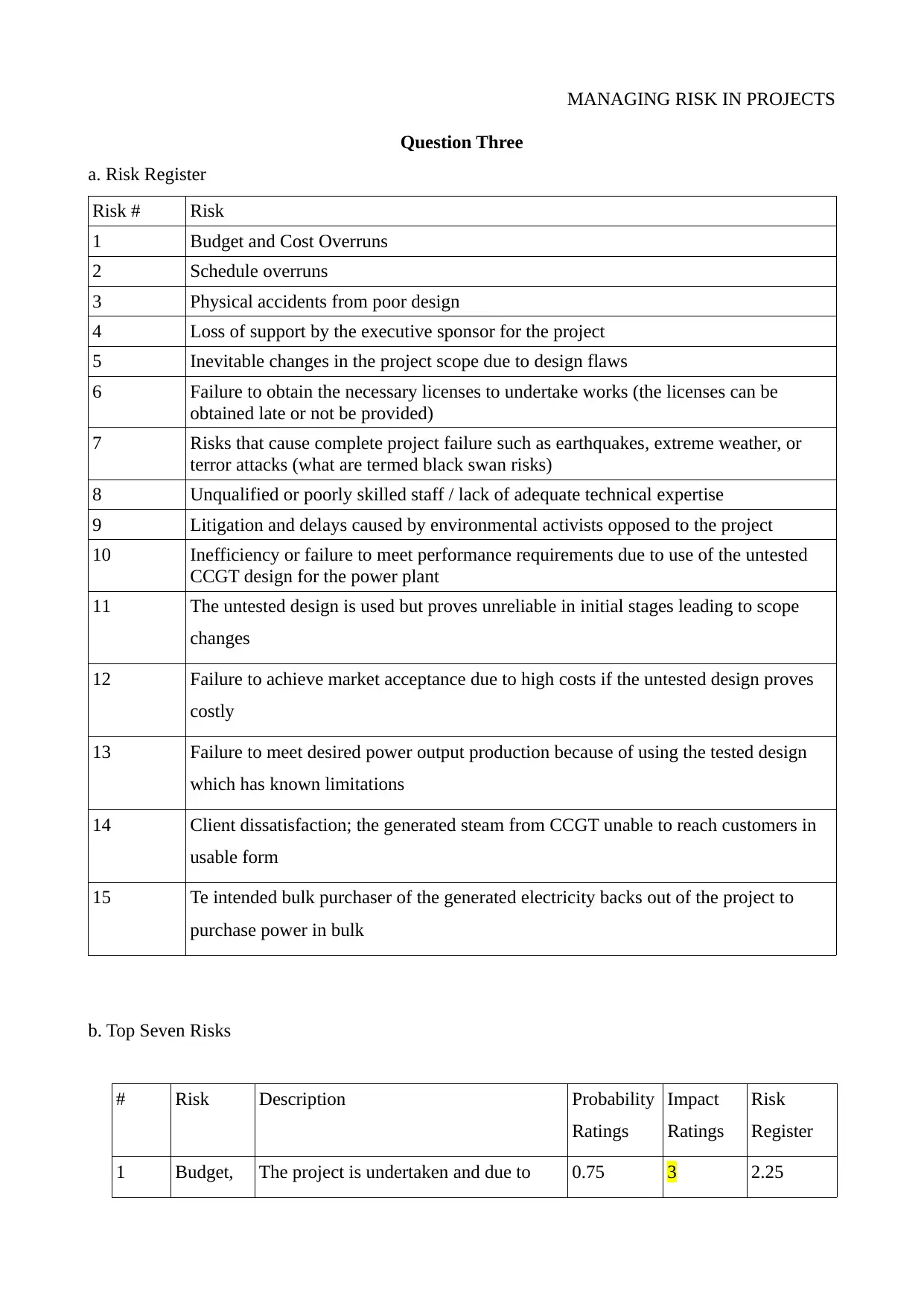
MANAGING RISK IN PROJECTS
Question Three
a. Risk Register
Risk # Risk
1 Budget and Cost Overruns
2 Schedule overruns
3 Physical accidents from poor design
4 Loss of support by the executive sponsor for the project
5 Inevitable changes in the project scope due to design flaws
6 Failure to obtain the necessary licenses to undertake works (the licenses can be
obtained late or not be provided)
7 Risks that cause complete project failure such as earthquakes, extreme weather, or
terror attacks (what are termed black swan risks)
8 Unqualified or poorly skilled staff / lack of adequate technical expertise
9 Litigation and delays caused by environmental activists opposed to the project
10 Inefficiency or failure to meet performance requirements due to use of the untested
CCGT design for the power plant
11 The untested design is used but proves unreliable in initial stages leading to scope
changes
12 Failure to achieve market acceptance due to high costs if the untested design proves
costly
13 Failure to meet desired power output production because of using the tested design
which has known limitations
14 Client dissatisfaction; the generated steam from CCGT unable to reach customers in
usable form
15 Te intended bulk purchaser of the generated electricity backs out of the project to
purchase power in bulk
b. Top Seven Risks
# Risk Description Probability
Ratings
Impact
Ratings
Risk
Register
1 Budget, The project is undertaken and due to 0.75 3 2.25
Question Three
a. Risk Register
Risk # Risk
1 Budget and Cost Overruns
2 Schedule overruns
3 Physical accidents from poor design
4 Loss of support by the executive sponsor for the project
5 Inevitable changes in the project scope due to design flaws
6 Failure to obtain the necessary licenses to undertake works (the licenses can be
obtained late or not be provided)
7 Risks that cause complete project failure such as earthquakes, extreme weather, or
terror attacks (what are termed black swan risks)
8 Unqualified or poorly skilled staff / lack of adequate technical expertise
9 Litigation and delays caused by environmental activists opposed to the project
10 Inefficiency or failure to meet performance requirements due to use of the untested
CCGT design for the power plant
11 The untested design is used but proves unreliable in initial stages leading to scope
changes
12 Failure to achieve market acceptance due to high costs if the untested design proves
costly
13 Failure to meet desired power output production because of using the tested design
which has known limitations
14 Client dissatisfaction; the generated steam from CCGT unable to reach customers in
usable form
15 Te intended bulk purchaser of the generated electricity backs out of the project to
purchase power in bulk
b. Top Seven Risks
# Risk Description Probability
Ratings
Impact
Ratings
Risk
Register
1 Budget, The project is undertaken and due to 0.75 3 2.25
Paraphrase This Document
Need a fresh take? Get an instant paraphrase of this document with our AI Paraphraser
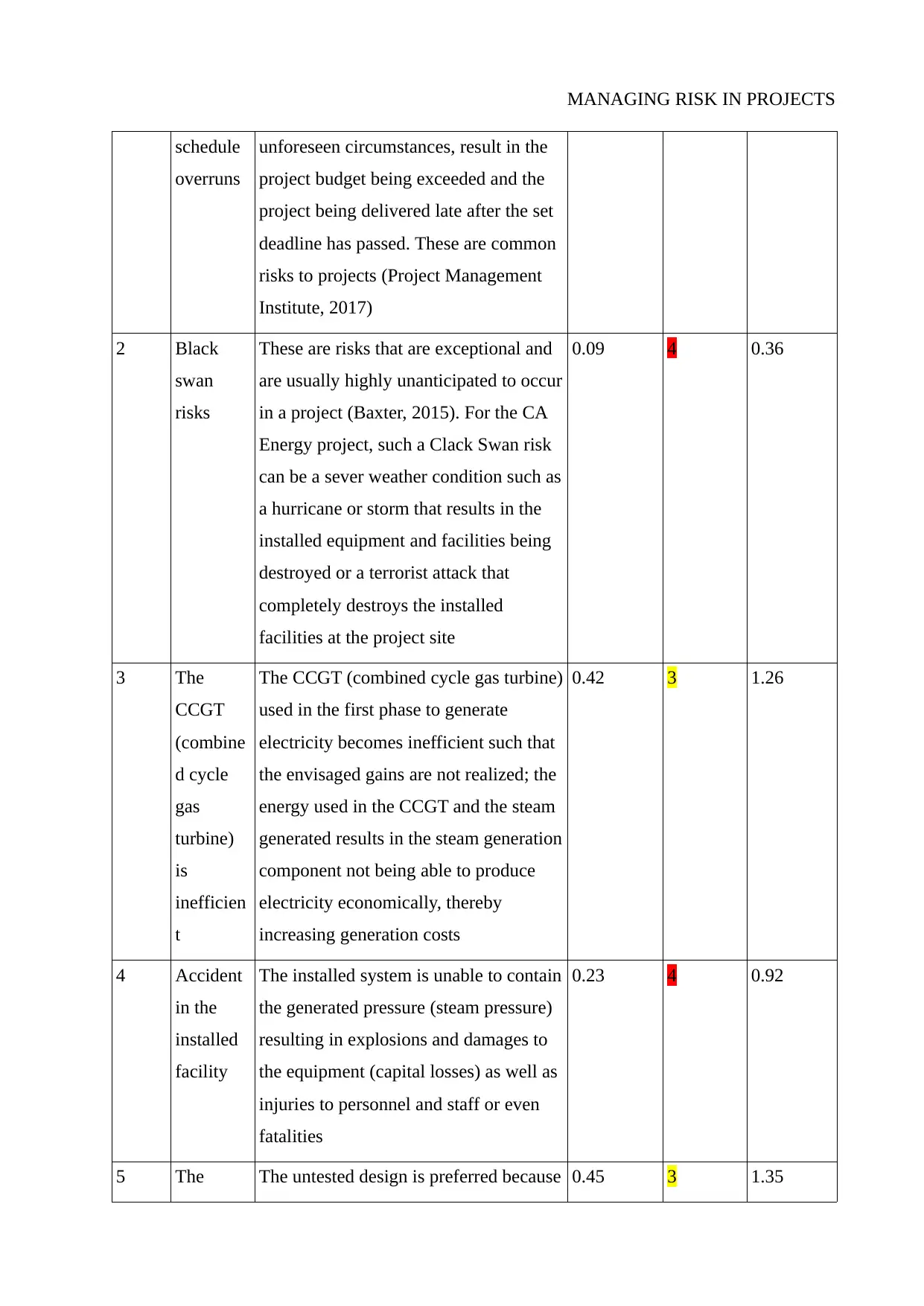
MANAGING RISK IN PROJECTS
schedule
overruns
unforeseen circumstances, result in the
project budget being exceeded and the
project being delivered late after the set
deadline has passed. These are common
risks to projects (Project Management
Institute, 2017)
2 Black
swan
risks
These are risks that are exceptional and
are usually highly unanticipated to occur
in a project (Baxter, 2015). For the CA
Energy project, such a Clack Swan risk
can be a sever weather condition such as
a hurricane or storm that results in the
installed equipment and facilities being
destroyed or a terrorist attack that
completely destroys the installed
facilities at the project site
0.09 4 0.36
3 The
CCGT
(combine
d cycle
gas
turbine)
is
inefficien
t
The CCGT (combined cycle gas turbine)
used in the first phase to generate
electricity becomes inefficient such that
the envisaged gains are not realized; the
energy used in the CCGT and the steam
generated results in the steam generation
component not being able to produce
electricity economically, thereby
increasing generation costs
0.42 3 1.26
4 Accident
in the
installed
facility
The installed system is unable to contain
the generated pressure (steam pressure)
resulting in explosions and damages to
the equipment (capital losses) as well as
injuries to personnel and staff or even
fatalities
0.23 4 0.92
5 The The untested design is preferred because 0.45 3 1.35
schedule
overruns
unforeseen circumstances, result in the
project budget being exceeded and the
project being delivered late after the set
deadline has passed. These are common
risks to projects (Project Management
Institute, 2017)
2 Black
swan
risks
These are risks that are exceptional and
are usually highly unanticipated to occur
in a project (Baxter, 2015). For the CA
Energy project, such a Clack Swan risk
can be a sever weather condition such as
a hurricane or storm that results in the
installed equipment and facilities being
destroyed or a terrorist attack that
completely destroys the installed
facilities at the project site
0.09 4 0.36
3 The
CCGT
(combine
d cycle
gas
turbine)
is
inefficien
t
The CCGT (combined cycle gas turbine)
used in the first phase to generate
electricity becomes inefficient such that
the envisaged gains are not realized; the
energy used in the CCGT and the steam
generated results in the steam generation
component not being able to produce
electricity economically, thereby
increasing generation costs
0.42 3 1.26
4 Accident
in the
installed
facility
The installed system is unable to contain
the generated pressure (steam pressure)
resulting in explosions and damages to
the equipment (capital losses) as well as
injuries to personnel and staff or even
fatalities
0.23 4 0.92
5 The The untested design is preferred because 0.45 3 1.35
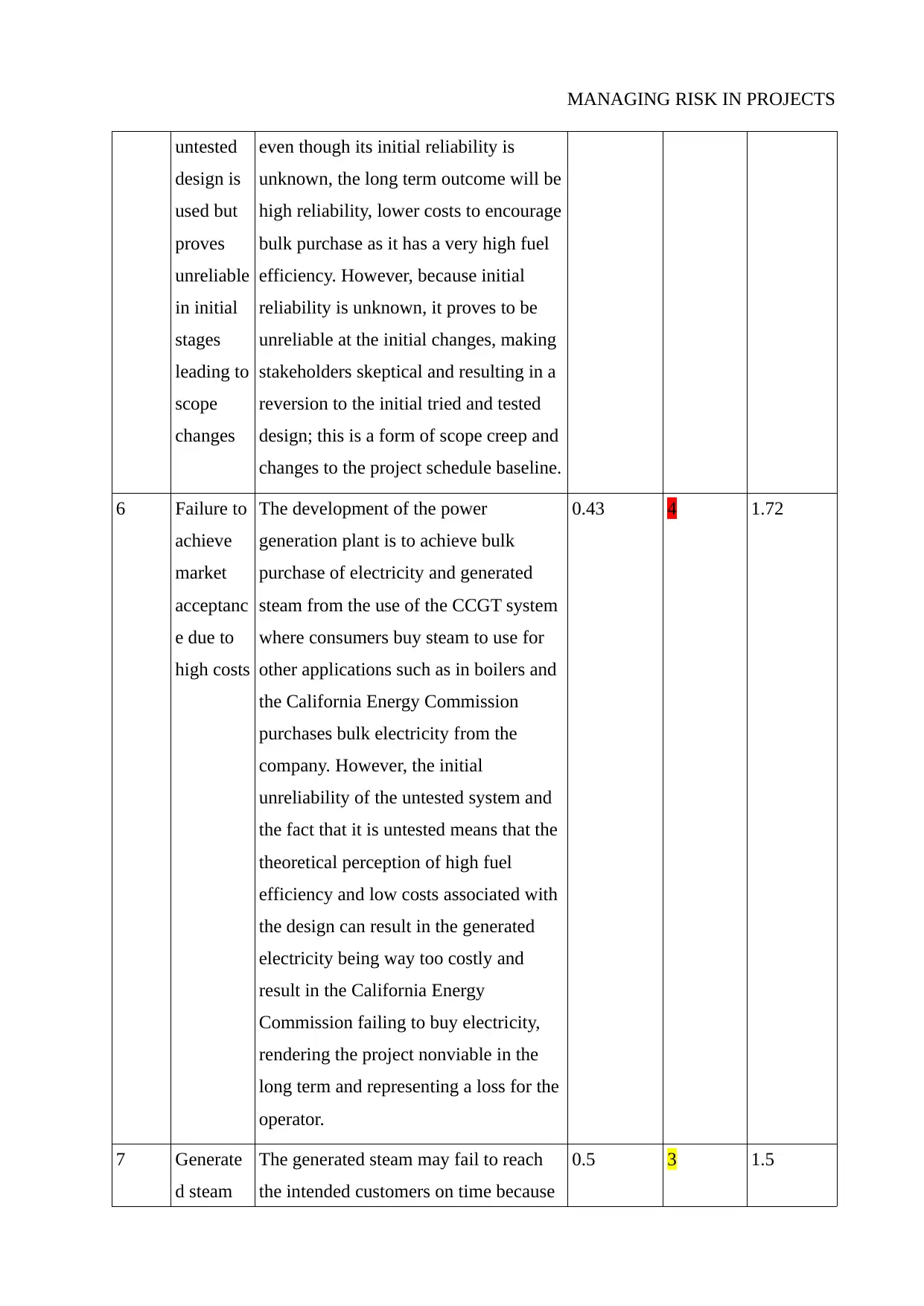
MANAGING RISK IN PROJECTS
untested
design is
used but
proves
unreliable
in initial
stages
leading to
scope
changes
even though its initial reliability is
unknown, the long term outcome will be
high reliability, lower costs to encourage
bulk purchase as it has a very high fuel
efficiency. However, because initial
reliability is unknown, it proves to be
unreliable at the initial changes, making
stakeholders skeptical and resulting in a
reversion to the initial tried and tested
design; this is a form of scope creep and
changes to the project schedule baseline.
6 Failure to
achieve
market
acceptanc
e due to
high costs
The development of the power
generation plant is to achieve bulk
purchase of electricity and generated
steam from the use of the CCGT system
where consumers buy steam to use for
other applications such as in boilers and
the California Energy Commission
purchases bulk electricity from the
company. However, the initial
unreliability of the untested system and
the fact that it is untested means that the
theoretical perception of high fuel
efficiency and low costs associated with
the design can result in the generated
electricity being way too costly and
result in the California Energy
Commission failing to buy electricity,
rendering the project nonviable in the
long term and representing a loss for the
operator.
0.43 4 1.72
7 Generate
d steam
The generated steam may fail to reach
the intended customers on time because
0.5 3 1.5
untested
design is
used but
proves
unreliable
in initial
stages
leading to
scope
changes
even though its initial reliability is
unknown, the long term outcome will be
high reliability, lower costs to encourage
bulk purchase as it has a very high fuel
efficiency. However, because initial
reliability is unknown, it proves to be
unreliable at the initial changes, making
stakeholders skeptical and resulting in a
reversion to the initial tried and tested
design; this is a form of scope creep and
changes to the project schedule baseline.
6 Failure to
achieve
market
acceptanc
e due to
high costs
The development of the power
generation plant is to achieve bulk
purchase of electricity and generated
steam from the use of the CCGT system
where consumers buy steam to use for
other applications such as in boilers and
the California Energy Commission
purchases bulk electricity from the
company. However, the initial
unreliability of the untested system and
the fact that it is untested means that the
theoretical perception of high fuel
efficiency and low costs associated with
the design can result in the generated
electricity being way too costly and
result in the California Energy
Commission failing to buy electricity,
rendering the project nonviable in the
long term and representing a loss for the
operator.
0.43 4 1.72
7 Generate
d steam
The generated steam may fail to reach
the intended customers on time because
0.5 3 1.5
⊘ This is a preview!⊘
Do you want full access?
Subscribe today to unlock all pages.

Trusted by 1+ million students worldwide
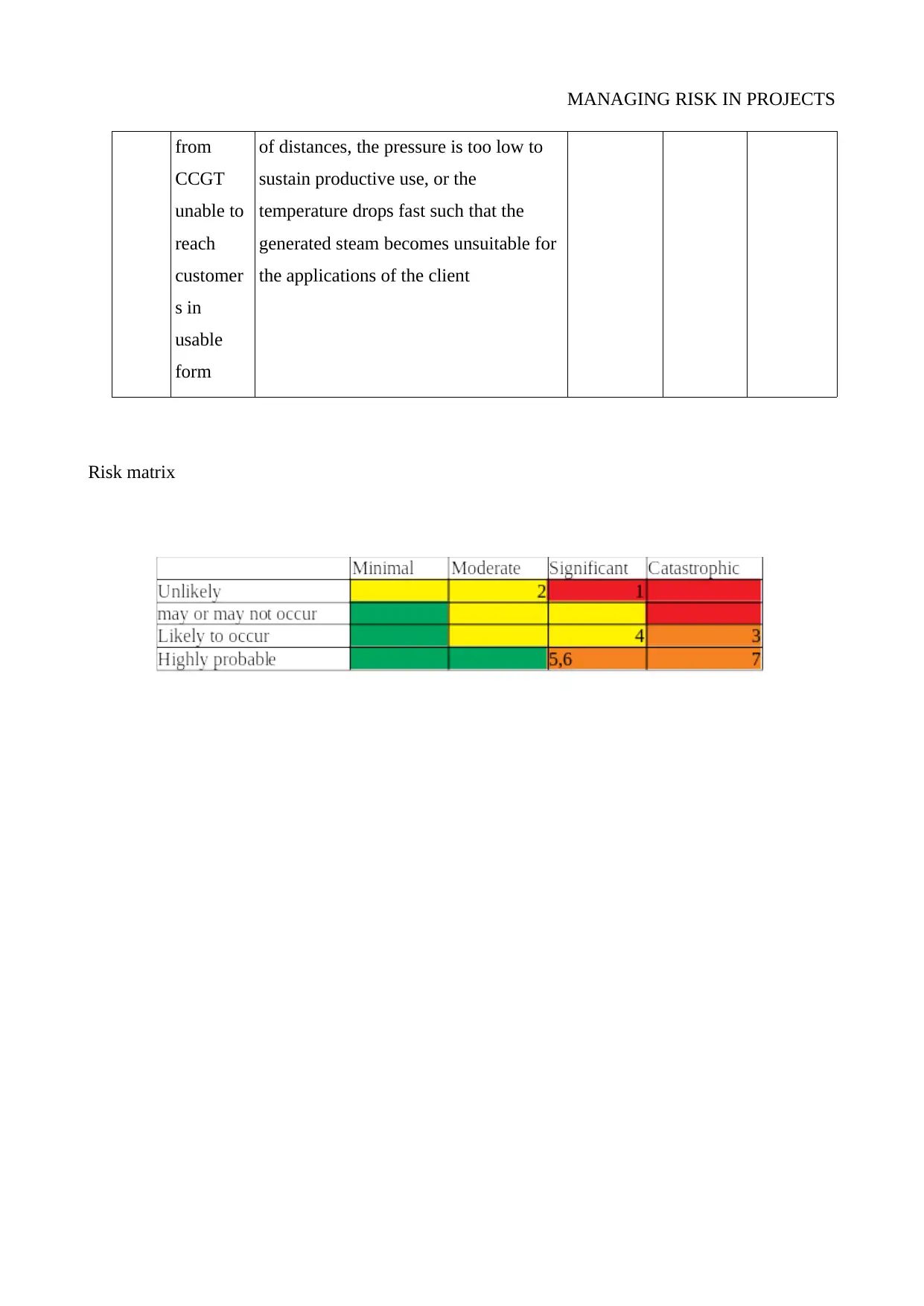
MANAGING RISK IN PROJECTS
from
CCGT
unable to
reach
customer
s in
usable
form
of distances, the pressure is too low to
sustain productive use, or the
temperature drops fast such that the
generated steam becomes unsuitable for
the applications of the client
Risk matrix
from
CCGT
unable to
reach
customer
s in
usable
form
of distances, the pressure is too low to
sustain productive use, or the
temperature drops fast such that the
generated steam becomes unsuitable for
the applications of the client
Risk matrix
Paraphrase This Document
Need a fresh take? Get an instant paraphrase of this document with our AI Paraphraser
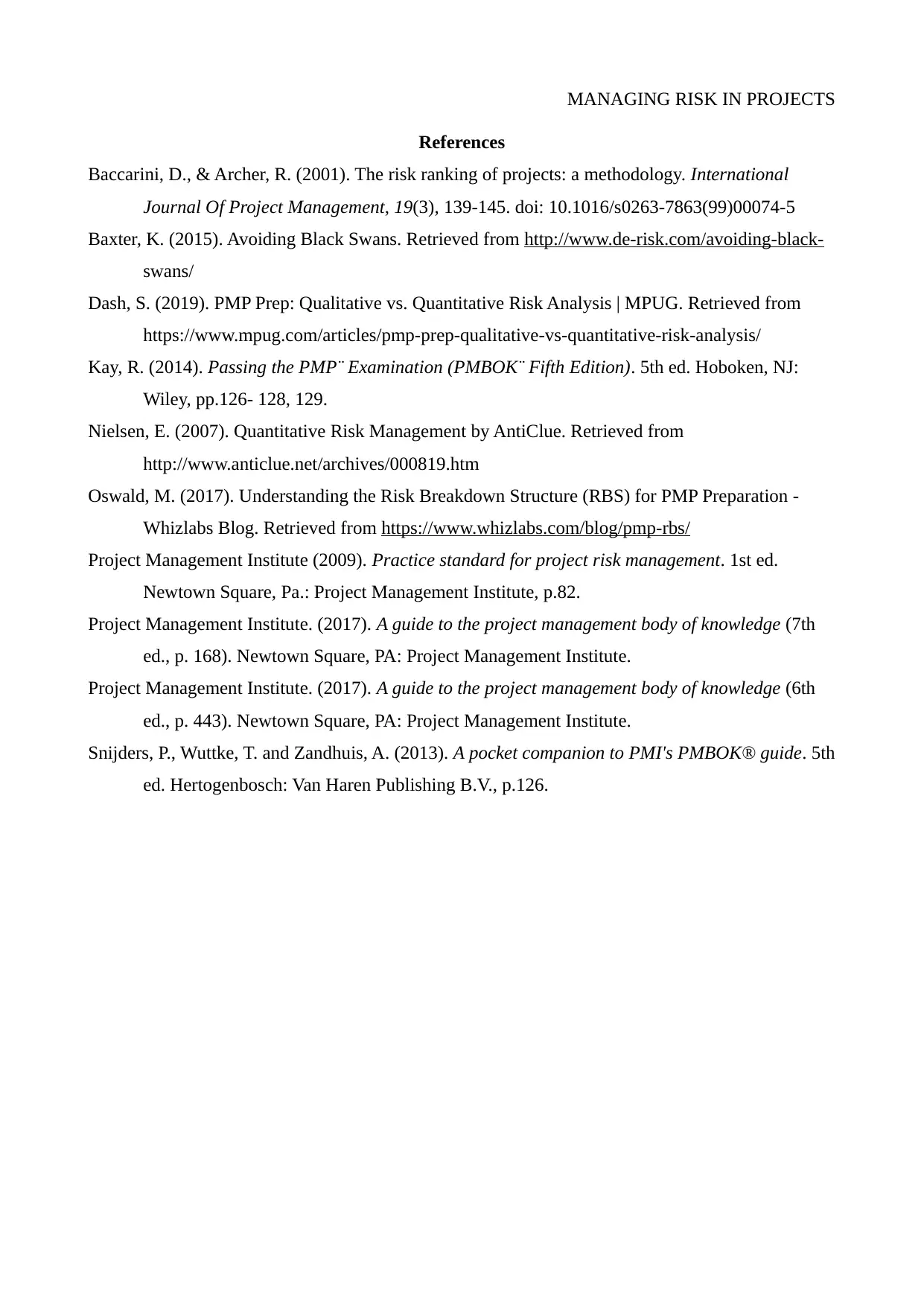
MANAGING RISK IN PROJECTS
References
Baccarini, D., & Archer, R. (2001). The risk ranking of projects: a methodology. International
Journal Of Project Management, 19(3), 139-145. doi: 10.1016/s0263-7863(99)00074-5
Baxter, K. (2015). Avoiding Black Swans. Retrieved from http://www.de-risk.com/avoiding-black-
swans/
Dash, S. (2019). PMP Prep: Qualitative vs. Quantitative Risk Analysis | MPUG. Retrieved from
https://www.mpug.com/articles/pmp-prep-qualitative-vs-quantitative-risk-analysis/
Kay, R. (2014). Passing the PMP¨ Examination (PMBOK¨ Fifth Edition). 5th ed. Hoboken, NJ:
Wiley, pp.126- 128, 129.
Nielsen, E. (2007). Quantitative Risk Management by AntiClue. Retrieved from
http://www.anticlue.net/archives/000819.htm
Oswald, M. (2017). Understanding the Risk Breakdown Structure (RBS) for PMP Preparation -
Whizlabs Blog. Retrieved from https://www.whizlabs.com/blog/pmp-rbs/
Project Management Institute (2009). Practice standard for project risk management. 1st ed.
Newtown Square, Pa.: Project Management Institute, p.82.
Project Management Institute. (2017). A guide to the project management body of knowledge (7th
ed., p. 168). Newtown Square, PA: Project Management Institute.
Project Management Institute. (2017). A guide to the project management body of knowledge (6th
ed., p. 443). Newtown Square, PA: Project Management Institute.
Snijders, P., Wuttke, T. and Zandhuis, A. (2013). A pocket companion to PMI's PMBOK® guide. 5th
ed. Hertogenbosch: Van Haren Publishing B.V., p.126.
References
Baccarini, D., & Archer, R. (2001). The risk ranking of projects: a methodology. International
Journal Of Project Management, 19(3), 139-145. doi: 10.1016/s0263-7863(99)00074-5
Baxter, K. (2015). Avoiding Black Swans. Retrieved from http://www.de-risk.com/avoiding-black-
swans/
Dash, S. (2019). PMP Prep: Qualitative vs. Quantitative Risk Analysis | MPUG. Retrieved from
https://www.mpug.com/articles/pmp-prep-qualitative-vs-quantitative-risk-analysis/
Kay, R. (2014). Passing the PMP¨ Examination (PMBOK¨ Fifth Edition). 5th ed. Hoboken, NJ:
Wiley, pp.126- 128, 129.
Nielsen, E. (2007). Quantitative Risk Management by AntiClue. Retrieved from
http://www.anticlue.net/archives/000819.htm
Oswald, M. (2017). Understanding the Risk Breakdown Structure (RBS) for PMP Preparation -
Whizlabs Blog. Retrieved from https://www.whizlabs.com/blog/pmp-rbs/
Project Management Institute (2009). Practice standard for project risk management. 1st ed.
Newtown Square, Pa.: Project Management Institute, p.82.
Project Management Institute. (2017). A guide to the project management body of knowledge (7th
ed., p. 168). Newtown Square, PA: Project Management Institute.
Project Management Institute. (2017). A guide to the project management body of knowledge (6th
ed., p. 443). Newtown Square, PA: Project Management Institute.
Snijders, P., Wuttke, T. and Zandhuis, A. (2013). A pocket companion to PMI's PMBOK® guide. 5th
ed. Hertogenbosch: Van Haren Publishing B.V., p.126.
1 out of 11
Related Documents
Your All-in-One AI-Powered Toolkit for Academic Success.
+13062052269
info@desklib.com
Available 24*7 on WhatsApp / Email
![[object Object]](/_next/static/media/star-bottom.7253800d.svg)
Unlock your academic potential
Copyright © 2020–2025 A2Z Services. All Rights Reserved. Developed and managed by ZUCOL.





